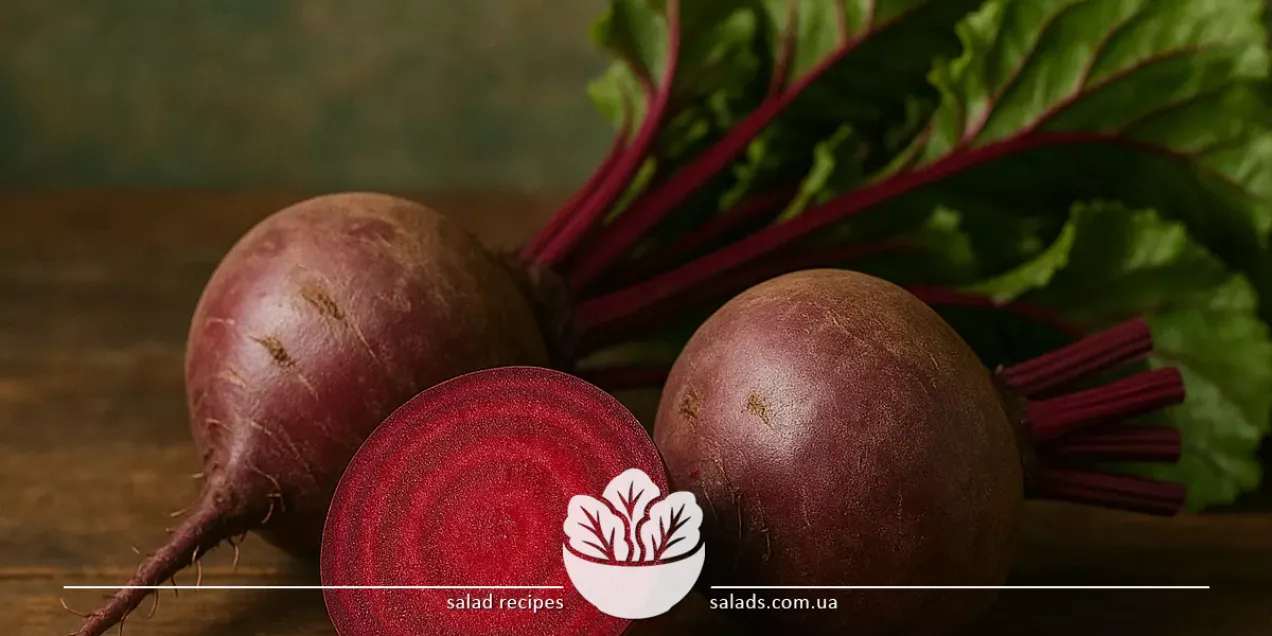
Beetroot

Beetroot is a vibrant and flavorful root vegetable that is an essential ingredient in many dishes of Ukrainian and world cuisine. It is used boiled, baked, or raw to prepare salads, borscht, appetizers, sauces, and side dishes. Beetroot combines well with fish, meat, vegetables, cheese, spices, herbs, and various dressings. In the root vegetables section, you can find more ways to prepare different vegetables to diversify your recipes and enhance their flavor profile.
Beetroot Salad Recipes
Beetroot Salads: Vibrant Color and Rich Flavor
Beetroot is one of the most commonly used ingredients for salads, especially in boiled or roasted form. Its intense color and pleasant sweetness add both flavor depth and visual appeal to dishes. It pairs well with other vegetables, dairy products, fish, meat, eggs, and a variety of dressings. The most well-known example is the classic vinaigrette, where beetroot plays a central role alongside potatoes, carrots, pickles, and green peas. Other popular variations include beetroot salad with garlic and sour cream, with walnuts and prunes, or with feta cheese and herbs. In vegetarian versions, beetroot is often served with seeds, legumes, or a lemon juice or vinegar-based dressing. For a more contrasting and balanced flavor, beetroot is combined with pickled vegetables, onions, spices, or fish. For instance, in a salad with salted herring, beetroot, potatoes, carrots, and egg, the result is the well-known layered dish – “shuba”. Beetroot also pairs beautifully with fresh vegetables in salads with vegetable oil, where its taste shines in simplicity and harmony.
Beetroot Soups: Borscht and More
Beetroot is the key ingredient in many soups, especially borscht – one of the most iconic Ukrainian dishes. It gives borscht its distinctive color, sweet undertone, and rich aroma. It is used fresh, sautéed, or stewed, often in combination with tomato, cabbage, potatoes, carrots, onions, and meat broth. In addition to borscht, beetroot is used in cold soups, vegetable soups, and creamy pureed soups. In the classic borscht recipe, beetroot is grated or julienned, sautéed with tomato paste, and then added to the broth along with other vegetables. In vegetarian versions, beetroot is combined with legumes, grains, or mushrooms, creating a deep and balanced flavor without meat. Beetroot is also featured in light summer soups – such as kefir-based cold soup or beetroot gazpacho. In modern soup variations, beetroot is often served as a purée – with cream, yogurt, horseradish, or mustard. Such beetroot cream soup has an elegant appearance and a rich, distinctive flavor, especially when complemented with toasted seeds, soft cheese, or croutons. Beetroot in soups is not only a tradition but also a source of culinary creativity, allowing you to rediscover a familiar ingredient.
Beetroot Appetizers: Light, Spicy, and Original
Beetroot is great for making both cold and hot appetizers. Its tender texture and natural sweetness pair well with spicy, tangy, or creamy elements. It’s used to make pâtés, rolls, canapés, stuffed eggs, creamy spreads, and layered salads. Beetroot also serves as an excellent base for festive presentations due to its color and ability to hold shape. One of the most popular options is beetroot caviar – an appetizer made from boiled beetroot, sautéed onions, carrots, and tomato paste, served chilled on bread or as a side. Beetroot is also often grated and mixed with garlic, nuts, and sour cream to make a creamy, aromatic spread. In vegetarian dishes, beetroot is served with legumes, herbs, or avocado paste. Another interesting option is beetroot rolls filled with hard cheese or cream cheese. In this context, beetroot becomes a delicate shell for a savory filling, creating a harmonious flavor contrast. For example, when combined with hard cheese and herbs, beetroot is not only tasty but also visually appealing. These appetizers are suitable for both everyday meals and festive occasions.
Beetroot in Side Dishes, Casseroles, and Vegetable Meals
Thanks to its vivid color, sweet flavor, and high nutritional value, beetroot is often used in side dishes and vegetable meals. It can be baked, stewed, fried, or steamed, and served either on its own or as part of a vegetable mix. Beetroot pairs well with cream, garlic, butter, herbs, spices, and other vegetables like carrots, potatoes, or cauliflower. One of the simplest options is baked beetroot with garlic and olive oil – a dish that preserves its natural flavor and nutrients. It is also commonly added to casseroles made with potatoes, cheese, or eggs. In grain-based dishes, beetroot goes well with barley, bulgur, or buckwheat, adding color and depth. For a smoother texture, it is grated or blended. For instance, a casserole with beetroot, green onion, and creamy sauce has a tender consistency and pleasant aroma. Combined with aromatic herbs and cheese, beetroot reveals new flavor dimensions, especially when baked. These side dishes and baked meals are suitable for everyday dining and can also serve as an interesting alternative to traditional vegetable sides.
Beetroot with Fish, Meat, and Sauces: A Flavorful Harmony
Beetroot pairs excellently with meat and fish ingredients, creating balanced and flavorful dishes. Its sweetness and firm texture make it a natural contrast to salty, smoked, or fatty proteins. In such recipes, beetroot can serve as the main component or a complement – in salads, side dishes, appetizers, or main courses. The most common combination is beetroot with herring, as in the classic layered dish “shuba,” where vegetables and fish create a vivid, flavorful composition. Beetroot is also served with boiled meat, liver, or chicken – often in salads with sour cream or mayonnaise-based dressings. In modern recipes, beetroot is roasted together with meat or served as a side – for example, with horseradish, mustard, or honey-based sauces. A notable example is a salad of roasted beetroot, herbs, soft cheese, and fresh cucumber, served with a light mustard dressing. This dish is perfect for summer menus, combining freshness with nutritional value. In meat-based variations, beetroot can counterbalance fried or smoked components, harmonizing both taste and texture.
